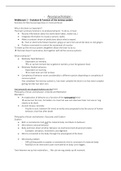Class notes
Comprehensive college notes including all images
- Course
- Institution
This document contains all the lectures in the course of neuropsychology. It provides a clear overview of all the material you need to learn before the exam. The document contains all slides including important additions that were discussed during the lectures.
[Show more]



